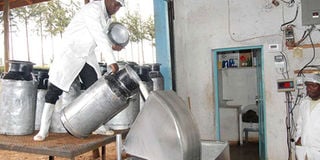Dairy farmers leading a dog’s life

Ongoing milk processing at Mumberes Dairy Co-operative Society in Baringo County on August 9, 2019. Dairy farmers are not pleased with their returns. PHOTO | FRANCIS MUREITHI | NATION MEDIA GROUP
What you need to know:
- At between Sh100 and Sh110 a litre, processors have exaggerated the selling price by over 400 per cent to protect their profits.
- Kenya Dairy Farmers Federation chairman Stanley Ng’ombe blamed the current glut on inflows from neighbouring countries.
Milk processors have reduced purchase prices for a litre by over 40 per cent in the past two months to Sh25 and below, but continue selling the commodity for up to Sh110 to consumers.
This is four times more than the purchase price, a rip off that has made dairy farmers some of the most exploited in the region.
Though there are other costs associated with milk business, among them transport, storage, processing, packaging and distribution, the huge disparity between what they pay farmers and what the consumers are charged is unrivalled by any other food product processed locally.
A visit to a number of supermarkets across the country shows that a litre of milk is retailing at between Sh100 to Sh110, or Sh50 to Sh55 for half a litre.
Brookside is the most expensive brand in the market, with most retailers selling half-a-litre at Sh55. Other brands such as KCC, Tuzo and Fresha are selling at Sh50 for half-a-litre.
Daima and Lato are some of the cheapest brands, selling from Sh45-Sh47 for a half-litre packet. The 500ml packet is the most preferred size in the market.
GREED
At between Sh100 and Sh110 a litre, processors have exaggerated the selling price by over 400 per cent to protect their profits.
At the same time, they are denying consumers any benefits that have come from falling farm-gate prices.
In an ideal competitive market where forces of demand and supply work, a fall in price on the supply side usually translates to reduction of prices on the shelf.
But this is not happening in Kenya when it comes to milk. A few months ago, processors were buying the same commodity at Sh35.
But a glut caused by imports and improved weather has seen the processors quickly adjust their prices downwards, but kept the retail price at the same level.
What is worse, by the time the milk gets to the supermarket and the shops, processors would have squeezed out fat to make butter and other products, before packaging what is left to be sold to the end consumer.
The Kenya Dairy Board (KDB), which promised last year to regulate milk prices to protect farmers against exploitation by processors, refused to comment on this story.
Ms Margaret Kibogy, the managing director, asked us to call her after 10 minutes when we asked for her comment.
PRICE LIST
She later did not pick calls or reply to our text message.
The current affairs have outraged farmers across the country, as some processors further push down the price for a litre of milk to Sh21.
Brookside and New KCC are paying milk producers between Sh27 and Sh31 per litre, depending on the volumes supplied.
Brookside will now pay Sh27 per litre to a farmer supplying between a litre and 100 litres, Sh28 for between 1,001-2,500 litres and Sh31 for 5,001 litres and above.
New KCC is paying between Sh27 and Sh30 a litre.
Mr Stanley Ng’ombe, the chairman of the Kenya Dairy Farmers Federation, blamed the current glut on inflows from neighbouring countries.
“Whereas we understand there are regional trade treaties that allow free trade, we know that powder milk is reconstituted in a neighbouring country and ferried to Kenya, leading to a milk glut,” he said.
He added that the cost of production has gone up in recent months, with the price of maize used to make feeds rising from Sh2,500 to Sh3,500 per 90kg bag.
IMPROVED PRODUCTION
Similarly, a bale of hay is currently going for up to Sh300 from Sh100.
According to farmers, it costs them Sh22 to produce a litre of milk, apart from other expenses, and lowering the prices to Sh25 renders the sector unprofitable.
“The processors need to involve farmers in setting milk prices,” said Mr Joshua Too, a dairy farmer from Chepkumia in Nandi County.
The drop in milk price comes when farmers in the North Rift have invested in modern production techniques following support from the Ministry of Agriculture and Livestock and development partners.
Dairy farmers in Uasin Gishu County, for instance, earned about Sh3 billion from over 186 million litres of milk last season, thanks to the Smallholder Dairy Commercialisation Programme run by the Agriculture ministry and donors.
“We fail to understand why processors are quick to enter contracts with us on milk deliveries yet they do not consult us when deciding on prices,” said Mr Henry Otsialo, from Naitiri in Bungoma County.
PETITION
The farmers took issue with the slow reform process at the New KCC to act as market stabiliser and cushion them from exploitation by private processors.
In Nakuru, processors are currently buying raw milk at between Sh25 and Sh27 per litre, down from Sh35 a few months ago.
The Kenya Dairy Farmers Federation chief executive officer Gideon Birgen urged farmers to be patient as the federation roots for a proposal that compels processors to hand at least four per cent of the sale of the shelf milk to farmers.
“We are still preparing the petition and it will take us about six months. When it will be implemented as a law, all dairy farmers through various co-operatives will be safe,” said Mr Birgen.






